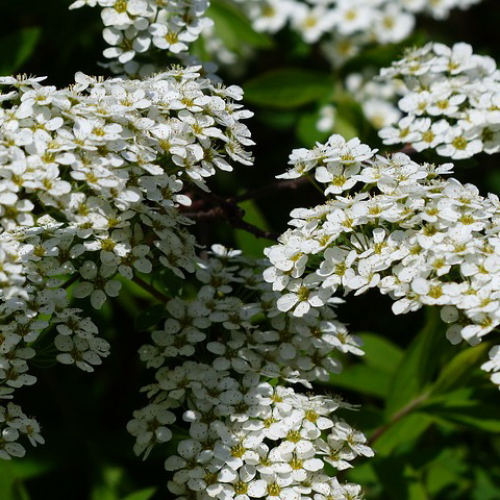Deciduous bushes Spiraeа

Description
Characteristic Features of Spiraea
Spiraea is a genus of perennial deciduous shrubs in the rose family Rosaceae.
The name of this ornamental plant comes from the Greek "speira" (a spiral or bending). Indeed, the branches of the shrub curve beautifully. Originally, Spiraea had a synonymous name of Meadowsweet but currently these plants are differentiated.
Depending on the species, Spiraea can reach 15 to 250 centimetres tall. The shrub has a shallow fibrous root system. Woody branches can be trailing or erect. Young shoots are typically pale green or yellowish, while mature shoots are brown with dark and light hues. The leaves are petiolate, alternate, with teethed margins. The inflorescences may be of various shapes and colours, depending on the flowering period. The flower has five round or oval petals and small stamen filaments. The fruit is a polyspermous follicle with flat brown seeds.
The genus Spiraea contains about 90 species, most of which have a wide range of varieties and cultivars.
Spring-blooming Spiraeas have a short flowering period, starting from the second half of May. They typically have umbellate white inflorescences. Below you will find a list of spring-bloomers:
Elm-Leaf Spiraea (Spiraea chamaedrifolia) grows up to 2 metres tall and has a rounded crown, erect branches, and corymbose inflorescences.
Bridal Wreath (Spiraea arguta) is a high shrub with narrow serrated deep green leaves, a broad crown, and snow-white flowers collected in umbellate inflorescences.
Spiraea cinerea has pubescent bluish-green leaves and ribbed corymbose inflorescences.
Russian Spiraea (Spiraea media) has oval deep green leaves and corymbose inflorescences.
Spiraea nipponica grows up to 1 metre tall. It has a spherical crown, curved branches, grey-green leaves, and yellowish-white flowers. It is less fussy about the soils but less frost-tolerant.
Van Houtte's Spiraea (Spiraea vanhouttei) can reach 2.5 metres tall and has long branches, grey-green leaves, and corymbose inflorescences.
Summer-blooming Spiraeas flower for a longer time, from mid-summer until the onset of very cold weather. They have corymbose or pyramidal white, pink, magenta, or red inflorescences on the branch ends. The most common species is Japanese Spiraea (Spiraea japonica) that has many ornamental varieties and has been increasingly gaining popularity. Other common ornamental varieties include the following:
Spiraea decumbens grows to 25 centimetres tall and has white inflorescences.
Bumald spirea (Spiraea x bumalda), a hybrid of Spiraea japonica and Spiraea albiflora, reaches about 1 metre tall, has oval leaves and attractive inflorescences on the shoot ends. In our climate, it needs to be winter sheltered.
Billiard Spiraea (Spiraea x billiardii) is a high shrub with long branches and crimson inflorescences.
Bridewort or Willowleaf Meadowsweet (Spiraea salicifolia) grows to about 2 metres high and has pink inflorescences and pale green leaves that turn red in the autumn.
White Meadowsweet (Spiraea betulifolia) has broad leaves and white or pink corymbose inflorescences. In the autumn, the shoots turn golden.
Thanks to a wide range of inflorescence shapes, flower colours, and shrub sizes, Spiraea enjoys well-deserved popularity among gardeners and is used for hedges, rockeries, borders, and mixed borders.
The best companion plants are the juniper, thuja, spruce, cypress, and weigela. Spiraea is perfect for cutting. It is a good honey plant and contains vitamin C, carotene, flavonoids, and tannins.
The Secrets to Successfully Growing Spiraea
Most Spiraea species are drought- and frost-resistant. They withstand temperature drop to -50 ° C but are demanding to soils. The soil should be fertile, loose, and well-drained. When choosing a place in the garden, remember that Spiraea prefers sunny areas. Care for Spiraea is quite simple and includes fertilization 3 times per season and moderate watering. Only young plants and some non-hardy varieties (spiraea nipponica, bumalda, and japonica) need to be winter sheltered.
Do not prune spring bloomers after flowering; just take away old and dry branches. Prune summer bloomers starting from the age of four in early spring every year to keep the shrub's shape.
To grow Spiraea from a seedling, plant it in September. Prepare a hole about 50 centimetres deep and fill it with a 15-20 centimetre layer of bricks shards and sand. Keep the root collar at ground level. Finish with watering and mulching with peat.
Spiraea species are propagated by seed, while cultivars are propagated by cuttings and layering.
Sow the seeds in March-April in containers with moist loam or peat. Two to four months later, when the seedlings get stronger, plant them out in open ground. Young plants need to be weeded and watered. You should also loosen the soil. In 3-4 years after planting, the seedlings start blooming. Remember that Spiraeas planted in groups should not crowd each other, so space them about 50 centimetres apart.
Spiraea is propagated by cuttings in the summer. Cut this year's shoots about 10 centimetres long, dip in growth stimulator, and plant out. For faster rooting, keep the soil moist by watering about 5 times per day or covering with PE film. In the spring, transplant rooted cuttings to a permanent location.
Spiraea is also frequently propagated by layering. In early spring, bend outermost branches down to the ground, tie to stakes, and cover with soil. For better growth, keep the soil moderately moist. In the winter, cover the shoots with dry leaves. In the spring, the young plants can be transplanted to a new location.
Potential Problems
In general, Spiraea is not prone to pests or diseases. Sometimes, especially in the summer, it can be affected by aphids that feed on the sap of young shoots. The leaves can be damaged by the Rosaceae leaf miners, leaf rollers, and spider mites. If you detect infestation, treat the plants with chemicals and ensure proper care. In a particularly dry season, mist the shrubs with water.







 5 351
5 351








